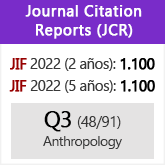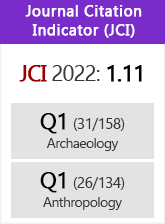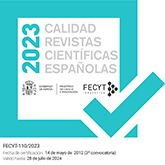Caracterización morfológica de almidones de los géneros Triticum y Hordeum en la Península Ibérica
DOI:
https://doi.org/10.3989/tp.2012.12095Palabras clave:
Almidones, Triticum, Hordeum, Recursos vegetales, Arqueobotánica, Análisis de residuos, Península IbéricaResumen
Los granos de almidón son cada vez más utilizados en los estudios arqueobotánicos como marcadores de la dieta, la domesticación de plantas, el uso de herramientas y la organización microespacial de los yacimientos arqueológicos, debido a que su morfología y características permiten identificar las plantas que los produjeron. En el presente trabajo se caracterizan morfométricamente los granos de almidón de cinco especies del género Triticum y tres variedades de Hordeum vulgare. Además se hace un balance de los estudios de almidones realizados en la Prehistoria de la Península Ibérica, señalando los logros, las debilidades y futuras directrices para potenciar este tipo de análisis bioarqueológico; especialmente la necesidad de contar con amplias colecciones de referencia, la aplicación de análisis estadísticos paralelos, y la realización de estudios experimentales para controlar los procesos de alteración de los almidones.
Descargas
Citas
Aceituno, F. J. y Loaiza, N. 2008: "Rastreando los orígenes de la agricultura en la vertiente oriental del Cauca medio". En C. López y G. Ospina (eds.): Ecología Histórica: interacciones sociedad ambiente a distintas escalas socio temporales. Universidad Tecnológica de Pereira-Universidad del Cauca-SCAR. Pereira: 68-73
Alonso, N.; Juan-Tresserras, J.; Rodríguez, M. O. y Rovira, N. 2003: "Muestreo arqueobotánico de yacimientos al aire libre y en medio seco." En R. Buxó y R. Piqué (dirs.): La recogida de muestras en Arqueobotánica: objetivos y propuestas metodológicas. La gestión de los recursos vegetales y la transformación del paleopaisaje en el Mediterráneo occidental. Museu d'Arqueologia de Catalunya. Barcelona: 29-46.
Aranguren, B.; Becattini, R.; Mariotti Lippi, M. y Revedin, A. 2007: "Grinding flour in Upper Palaeolithic Europe (25.000 years bp)". Antiquity 81: 845-855.Babot, M. 2003: "Starch grain damage as an indicator of food processing". En D. M. Hart y L. A. Wallis (eds.): Phytolith and Starch Research in the Australian-Pacific-Asian regions: the state of the art. Pandanus Press. Canberra: 69-81
Balme, J. y Beck, W. E. 2002: "Starch and charcoal: useful measures of activity areas in archaeological rockshelters". Journal of Archaeological Science 29: 157-166. http://dx.doi.org/10.1006/jasc.2001.0700
Barton, H. 2005: "The case for rainforest foragers: the starch record at Niah Cave, Sarawak". Asian Perspectives 44 (1): 56-72. http://dx.doi.org/10.1353/asi.2005.0005
Barton, H. 2007: "Starch residues on museum artefacts: implications for determining tool use". Journal of Archaeological Science 34: 1752-1762. http://dx.doi.org/10.1016/j.jas.2007.01.007
Blasco, A.; Edo, M.; Villalba, M. J.; Buxó, R.; Juan-Tresserras, J. y Saña, M. 1999: "Del cardial al postcardial en la cueva de San Sadurní (Begues, Barcelona). Primeros datos sobre su secuencia estratrigráfica, paleoeconómica y ambiental". En J. Bernabeu y T. Orozco (eds.): II Congrés del Neolític a la Península Ibèrica (València 1999). Saguntum-PLAV Extra-2, Universitat de València. València: 59-67
Bray, J. R. y Curtis, J. T. 1957: "An ordination of upland forest communities of Southern Wisconsin". Ecological Monographs 27: 325-349. http://dx.doi.org/10.2307/1942268
Buxó, R.; Alonso, N.; Canal, D.; Echave, C. y González, I. 1997: "Archaeobotanical remains of hulled and naked cereals in the Iberian Peninsula". Vegetation, History and Archaeobotany 6: 15-23. http://dx.doi.org/10.1007/BF01145882
Buxó, R. y Piqué, R. 2008: Arqueobotánica. Los usos de las plantas en la Península Ibérica. Ed. Ariel. Barcelona.
Coil, J.; Korstanje, M. A.; Archer, S. y Hastorf, C. A. 2003: "Laboratory goals and considerations for multiple microfossil extraction in archaeology". Journal of Archaeological Science 30: 991-1008. http://dx.doi.org/10.1016/S0305-4403(02)00285-6
Cortella A. R. y Pochettino, M. L. 1994: "Starch grain analysis as a microscopic diagnostic feature in the identification of plant material". Economic Botany 48: 171-181. http://dx.doi.org/10.1007/BF02908212Dickau, R. 2005: Resource use, crop dispersal, and the transition to agriculture in prehistoric Panama: evidence from starch grains and macroremains. Ph.D. Philadelphia: Doctoral Dissertation, Temple University.
Dickau, R.; Ranere, A. J. y Cooke R. 2007: "Starch grain evidence for the preceramic dispersals of maize and root crops into tropical dry and humid forest of Panama". Proceedings of the National Academy of Sciences of the United States of America 14: 3651-3656. http://dx.doi.org/10.1073/pnas.0611605104 PMid:17360697 PMCid:1805539
Esau, K. 1953: Plant anatomy. John Wiley & Sons Inc. New York. PMid:13056805
Franceschi, V. R. y Horner, H. T. 1980: "Calcium oxalate crystals in plants". Botanical Review 46: 361-427. http://dx.doi.org/10.1007/BF02860532
Fullagar, R.; Field, J.; Denham, T. y Lentfer, C. 2006: "Early and mid Holocene tool-use and processing of taro (Colocasia esculenta), yam (Dioscorea sp.) and other plants at Kuk Swamp in the highlands of Papua New Guinea". Journal of Archaeological Science 33: 595-614. http://dx.doi.org/10.1016/j.jas.2005.07.020
Fullagar, R.; Furby, J. y Hardy, B. L. 1996: "Residues on stone artefacts: state of a scientific art". Antiquity 70: 740-745.
Giovannetti, M. A.; Lema, V.; Bartoli, C. y Capparelli A. 2008: "Starch grains characterization of Prosopis chilensis (Mol.) Stuntz and P. flexuosa D.C, and their implications in the analysis of archaeological remains in Andean South America". Journal of Archaeological Science 35: 2973-2985. http://dx.doi.org/10.1016/j.jas.2008.06.009
Hardy, K.; Blakney, T.; Copeland. L.; Kirkham. J.; Wrangham, R. y Collins, M. 2009: "Starch granules, dental calculus and new perspectives on ancient diet". Journal of Archaeological Science 36: 248-255. http://dx.doi.org/10.1016/j.jas.2008.09.015
Haslam, M. 2004: "The decomposition of starch grain in soils: implications for archaeological residues analyses". Journal of Archaeological Science 31 (12): 1715-1734. http://dx.doi.org/10.1016/j.jas.2004.05.006
Henry, D. O.; Hietala, H. J.; Rosen, A. M.; Demidenko, Y. E. y Armagan, T. L. 2004: "Human behavioral organization in the Middle Paleolithic: were Neanderthals different?". American Anthropologist 106: 17-31. http://dx.doi.org/10.1525/aa.2004.106.1.17
Henry, A. G.; Hudson, H. F. y Piperno, D. R. 2009: "Changes in starch grain morphologies from cooking". Journal of Archaeological Science 36: 915-922. http://dx.doi.org/10.1016/j.jas.2008.11.008
Henry, A. G. y Piperno, D. 2008: "Using plant microfossils from dental calculus to recover human diet: a case study from Tell al-Raqa'i, Syria". Journal of Archaeological Science 35: 1943-1950. http://dx.doi.org/10.1016/j.jas.2007.12.005
Holst, I.; Moreno, J. E. y Piperno, D. R. 2007: "Identification of teosinte, maize and Tripsacum in Mesoamerica by using pollen, starch grains and phitoliths". Proceedings of the National Academy of Sciences of the United States of America 104: 17608-17613. http://dx.doi.org/10.1073/pnas.0708736104 PMid:17978176 PMCid:2077075
Hoover, R. 2001: "Composition molecular, structure, and physicochemical properties of tuber and root starches: a review". Carbohydrate Polimers 45 (3): 253-267. http://dx.doi.org/10.1016/S0144-8617(00)00260-5
Horrocks, M. 2005: "A combined procedure for recovering phytoliths and starch residues from soils, sedimentary deposist and similar materials". Journal of Archaeological Science 32: 1169-1175. http://dx.doi.org/10.1016/j.jas.2005.02.014
Horrocks, M.; Irwin, G.; Jones, M. y Sutton, D. 2004: "Starch grains and xylem cells of sweet potato (Ipomea batatas) and bracken (Pteridium esculentum) in archaeological deposits from northen New Zeland". Journal of Archaeological Science 31: 251-258. http://dx.doi.org/10.1016/S0305-4403(03)00018-9ICSN 2011: "The International Code for Starch Nomenclature". http://fossilfarm.org/ICSN/Code.html (consulta 13-I-2012)
Iriarte, J.; Holst, I.; Marozzi, O.; Listopad, C.; Alonso, E.; Rinderknecht, A. y Montaña, J. 2004: "Evidence for cultivar adoption and emerging complexity during the mid-Holocene in the la Plata basin". Nature 432: 614-617. http://dx.doi.org/10.1038/nature02983 PMid:15577908
Juan-Tresserras, J. 1995: "L'aplicació de nous mètodes en la investigació del món de la mort". Citerior, Revista d'Arqueologia i Ciències de l'Antiguitat 1: 203-210.Juan-Tresserras, J. 1998: "La cerveza prehistórica: investigaciones arqueobotánicas y experimentales". En J. L. Maya, F. Cuesta y J. L. López Pacheco (eds.): Genó: un poblado del Bronce Final en el Bajo Segre (Lleida). Publications Universitat de Barcelona. Barcelona: 239-252
Juan-Tresserras, J. 2000a: "Estudio de residuos vegetales conservados en recipientes y asociados a material de molienda en yacimientos de la Edad del Hierro del NE de la Península Ibérica". En R. Buxó y E. Pons (dirs.): Els productes alimentaris d'origen vegetal a l'edat del Ferro de l'Europa occidental: de la producció al consum. Museu d'Arqueologia de Catalunya. Girona: 371-377
Juan-Tresserras, J. 2000b: "Resultats de les anàlisis de residus en material de mòlta". Arqueomediterrània 5: 219-226.Juan-Tresserras, J. 2000c: "La explotación del territorio peninsular en la Protohistoria: vino, aceite, cereales y textiles. Aportaciones de los análisis arqueobotánicos y de compuestos orgánicos". En T. Ñaco, O. Olesti y A. Prieto (eds.): Análisis paleoambientals i estudi del territorio (Seminario de la COST ACTION G2, Barcelona 1988): 75-85. Barcelona
Juan-Tresserras, J. 2000d: "La cerveza: un producto de consumo básico entre las comunidades ibéricas del N.E. peninsular". En III Reunió sobre Economia en el Món Ibèric: Ibers. Agricultors, artesans i comerciants (València 1999). Saguntum-PLV Extra-3, Universitat de València. València: 141-148.
Juan-Tresserras, J.; Echave, C. y Albert, R. M. 1996: "El procesado de vegetales y la interpretación funcional del utillaje neolítico de molido y triturado en la Península Ibérica". En I Congrés del Neolític a la Península Ibérica (Gavà-Bellaterra 1995). Rubricatum 1 (1): 201-206.
Kealhofer, L.; Torrence, B. y Fullagar, R. 1999: "Integrating phytoliths within use-wear/residue studies of stone tools". Journal of Archaeological Science 26: 527-546. http://dx.doi.org/10.1006/jasc.1998.0332
Knutzon, C. A. y Grove, M. J. 1994: "Rapid method for estimation of amylose in maize starches". Cereal Chemistry 71: 469-471.Kurtzman, C. P. y Fell, J. W. 2005: "Biodiversity and ecophysiology of yeasts". En P. Gábor y C. L. de la Rosa (eds.): The Yeast Handbook. Springer. Berlin: 11-30
Lamb, J. y Loy, T. H. 2005: "Seeing red: the use of Congo Red dye to identify cooked and damaged starch grains in archaeological residues". Journal of Archaeological Science 32: 1433-1440. http://dx.doi.org/10.1016/j.jas.2005.03.020
Lentfer, C.; Therin, M. R. y Torrence, R. 2002: "Starch grains and environmental reconstruction: a modern test case from west new Britain, Papua New Guinea". Journal of Archaeological Science 29: 687-698. http://dx.doi.org/10.1006/jasc.2001.0783
Lineback, D. R. y Wongsrikasem, E. 1980: "Gelatinization of starch in baked products". Journal of Food Science 45: 71-74. http://dx.doi.org/10.1111/j.1365-2621.1980.tb03873.xLoy, T. 1994: "Methods in the analysis of starch residues on prehistoric stone tools". En J. G. Hather (ed.): Tropical archaeobotany. Applications and new developments. Routledge. London and New York: 86-111
Loy, T. H.; Spriggs, M. y Wickler, S. 1992: "Direct evidence for human use of plants 28,000 years ago: starch residues on stone artifacts from the northern Salomon Islands". Antiquity 66: 898-912.
McGee, H. 1984: On Food and Cooking: The Science and Lore of the Kitchen. Charles Scribner's Sons. New York.
Mercader, J. 2009: "Mozambican grass seed consumption during the Middle Stone Age". Science 326 (5960): 1680-1683. http://dx.doi.org/10.1126/science.1173966 PMid:20019285
Mock, C. y Dick, J. W. 1991: "Response of starch of different wheat classes to ball milling". Cereal Chemistry 68 (4): 409-412.
Pagan, J. R.; Rodríguez, M. A.; Chanlatte, L. A. y Narganes, Y. 2005: "La temprana introducción y uso de algunas plantas domésticas, silvestres y cultivos en las Antillas precolombinas. Una primera revaloración desde la perspectiva del arcaico de Vieques y Puerto Rico". Diálogo Antropológico 10: 7-33.
Pearsall, D. M.; Chadler-Ezell, K. y Zeidler, J. A. 2004: "Maize in ancient Ecuador: results of residue analysis of stone tools from the Real Alto site". Journal of Archaeological Science 31: 423-442. http://dx.doi.org/10.1016/j.jas.2003.09.010
Perry, L. 2002: "Starch granule size and the domestication of manioc (Manihot esculenta) and sweet potato (Ipomea batatas)". Economic Botany 56 (4): 335-349. http://dx.doi.org/10.1663/0013-0001(2002)056[0335:SGSATD]2.0.CO;2
Perry, L. 2004: "Starch analyses reveal the relationship between tool type and function: an example from Orinoco valley of Venezuela". Journal of Archaeological Science 31: 1069-1081. http://dx.doi.org/10.1016/j.jas.2004.01.002
Perry, L.; Dickau, R.; Zarrillo, S.; Holst, I.; Pearsall, D. M.; Piperno, D. R.; Berman, M. J.; Cooke, R. G.; Rademaker, K.; Ranere, A. J.; Raymond, J. S.; Sandweiss, D. H.; Scaramelli, F.; Tarble, K. y Zeidler, J. A. 2007: "Starch fossils and the domestication and dispersal of chili peppers (Capsicum spp. L.) in the Americas". Science 315: 986-988. http://dx.doi.org/10.1126/science.1136914 PMid:17303753
Piperno, D. 2006: Phytoliths: a comprehensive guide for archaeologists and paleoecologists. AltaMira Press. Lanham.
Piperno, D. 2009: "Crop plants with phytoliths (and starch grains) in Central and South America: A review and an update of the evidence". Quaternary International 193: 146-159. http://dx.doi.org/10.1016/j.quaint.2007.11.011
Piperno, D. y Dillehay, T. 2008: "Starch grains on human teeth reveal early broad crop diet in northen Peru". Proceedings of the National Academy of Sciences of the United States of America 105: 19622-19627. http://dx.doi.org/10.1073/pnas.0808752105 PMid:19066222 PMCid:2604935
Piperno, D. y Holst, I. 1998: "The presence of starch grains on prehistoric stone tools from de humid Neotropics: indications of early tuber use and agriculture en Panamá". Journal of Archaeological Science 25: 765-776. http://dx.doi.org/10.1006/jasc.1997.0258
Piperno, D. y Pearsall, D. 1998: The origins of agriculture in the lowland Neotropics. Academic Press. San Diego. PMCid:2132975
Piperno, D.; Ranere, A. J.; Holst, I. y Hansell, P. 2000: "Starch grains reveal early root crop horticulture in the Panamanian tropical forest". Nature 407: 894-897. http://dx.doi.org/10.1038/35038055 PMid:11057665
Piperno, D.; Weiss, E.; Holst, I. y Nadel, D. 2004: "Processing of wild cereals grains in the Upper Paleolithic revealed by starch grains analysis". Nature 430: 670-673. http://dx.doi.org/10.1038/nature02734 PMid:15295598
Reichert, E. T. 1913: The differentiation and specificity of starches in relation to genera, species, etc. The Carnegie Institute of Washington. Washington D.C.
Revedin, A.; Aranguren, B.; Becattini, R.; Longo, L.; Marconi, E.; Mariotti Lippi, M.; Skakun, N.; Sinitsyn, A.; Spiridonova, E. y Svoboda, J. 2010: "Thirty thousand-years-old evidence of plant food processing". Proceedings of the National Academy of Sciences of the United States of America 107: 18815-18819. http://dx.doi.org/10.1073/pnas.1006993107 PMid:20956317 PMCid:2973873
Rojo, M. A.; García Martínez de Lagrán, I. y Garrido Pena, R. 2002-2003: "La elaboración experimental de cerveza prehistórica en el valle de Ambrona". Boletín de Arqueología Experimental 5: 4-9.Samuel, D. 2000: "Brewing and baking". En P. T. Nicholson y I. Shaw (eds.): Ancient Egyptian materials and technology. Cambridge University Press. Cambridge: 537-576
Seidemann, J. 1966: Stärke-Atlas. Paul Parey. Berlin. Swinkels, J. J. M. 1985: "Sources of starch, its chemistry and physic". Starch Conversion Technology. Marcel Dekker. New York: 15-46
Therin, M.; Torrence, R. y Fullagar, R. 1997: "Australian Museum starch reference collection". Australian Archaeology 44: 52-53.
Thomas, H. D. y Atwell, W. A. 1999: Starches. Practical guides for the food industry. Egan Press. St. Paul, Minnesota.
Tomlinson, K. y Denyer, K. 2003: "Starch synthesis in cereal grains". Advances in Botanical Research 40: 1-47. http://dx.doi.org/10.1016/S0065-2296(05)40001-4
Torrence, R. y Barton, H. (eds.) 2006: Ancient starch research. Left Coast Press. Walnut Creek, California.Torrence, R. y Conway, R. 2006: "Classification using image analysis and multivariate techniques". En R. Torrence y H. Barton (eds.): Ancient Starch Research. Left Coast Press.Walnut Creek, California: 137-142
Ugent, D.; Pozorski, S. y Pozorski, T. 1982: "Archaeological potato tuber remains from the Casma valley of Peru". Economic Botany 36: 182-192. http://dx.doi.org/10.1007/BF02858715
Ugent, D.; Pozorski, S. y Pozorski, T. 1984: "New evidence for ancient cultivation of Canna edulis in Peru". Economy Botany 38: 417-432. http://dx.doi.org/10.1007/BF02859081
Ugent, D.; Pozorski, S. y Pozorski, T. 1986: "Archaeological manioc (Manihot) from coastal of Peru". Economy Botany 40: 78-102. http://dx.doi.org/10.1007/BF02858949Vasanthan, T. y Hoover, R. 2009: "Barley starch: production, properties, modification and uses". En J. BeMiller y R. Whistler (eds.): Starch: chemistry and technology. Academic Press. New York: 601-625
Wang, T. L.; Bogracheva, T. Y. y Hedley, C. L. 1997: "Starch: as simple as A, B, C?". Journal of Experimental Botany 28: 481-502.
Ward, J. 1963: "Hierarchical grouping to optimize and objective function". Journal of the American Statistical Association 58: 236-244. http://dx.doi.org/10.1080/01621459.1963.10500845
Wilson, J.; Hardy, K.; Allen, R.; Copeland, L.; Wrangham, R. y Collins, M. 2010: "Automated classification of starch granules using supervised pattern recognition of morphological properties". Journal of Archaeological Science 37: 594-604. http://dx.doi.org/10.1016/j.jas.2009.10.024
Yáñez, C.; Malgosa, A.; Burjachs, F.; Díaz, N.; García, C.; Isidro, A.; Juan, J. y Matamala, J. 2002: "El món funerari al final del V mil·lenni a Andorra: La Tomba de Segudet (Ordino)". Cypsela 14: 175-194.
Yuryev, V. P.; Nemirosvkaya, I. E. y Maslova, T. D. 1995: "Phase state of starch gels at different water content". Carbohydrate Polymers 26 (1): 43-46. http://dx.doi.org/10.1016/0144-8617(95)98833-3
Zapata, L.; Peña Chocarro, L.; Pérez Jordá, G. y Stika, H. P. 2004: "Early Neolithic agriculture in the Iberian Peninsula". Journal of World Prehistory 18 (4): 285-326. http://dx.doi.org/10.1007/s10963-004-5621-4
Zapata, L.; Peña Chocarro, L.; Pérez Jordá, G. y Stika, H. P. 2005: "Difusión de la agricultura en la Península Ibérica". En R. Ontañón Peredo, C. García-Moncó y P. Arias Cabal (eds.): III Congreso del Neolítico en la Península Ibérica (Santander 2003): 103-113. Santander.
Zhong-Min, D.; Yan-Ping, Y.; Min, Z.; Wen-Yang, L.; Su-Hui, Y.; Rui-Guo, C. y Zhen-lin, W. 2008: "Distribution of starch granule size in grains of wheat grown under irrigated and rain fed conditions". Acta Agronomica Sinica 34 (5): 795-802.
Zobel, J. F. 1988: "Molecules to granules: a comprehensive starch review". Starch/Stärke 40 (2): 41-50. http://dx.doi.org/10.1002/star.19880400203
Descargas
Publicado
Cómo citar
Número
Sección
Licencia
Derechos de autor 2012 Consejo Superior de Investigaciones Científicas (CSIC)

Esta obra está bajo una licencia internacional Creative Commons Atribución 4.0.
© CSIC. Los originales publicados en las ediciones impresa y electrónica de esta Revista son propiedad del Consejo Superior de Investigaciones Científicas, siendo necesario citar la procedencia en cualquier reproducción parcial o total.Salvo indicación contraria, todos los contenidos de la edición electrónica se distribuyen bajo una licencia de uso y distribución “Creative Commons Reconocimiento 4.0 Internacional ” (CC BY 4.0). Puede consultar desde aquí la versión informativa y el texto legal de la licencia. Esta circunstancia ha de hacerse constar expresamente de esta forma cuando sea necesario.
No se autoriza el depósito en repositorios, páginas web personales o similares de cualquier otra versión distinta a la publicada por el editor.

















